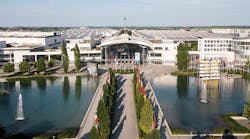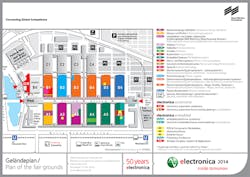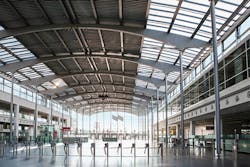Munich's mega techfest, aka the Electronica 2014 show, becomes golden this year, as it celebrates its 50th anniversary. From November 11 to 14, approximately 2700 electronics companies from around the globe will display their latest innovations.
For some people, the thought of visiting this enormous event, trudging many kilometers through what seems like a never-ending maze of exhibition halls, is about as attractive as a trip to the dentist’s office.
But forget those wannabe technology luddites. Fifty years in the making, Electronica is still considered by electronics engineers, designers, purchasers, and academics as an opportunity of utopian proportions to catch up on the latest electronics technology. That's why this year’s show expects to attract over 70,000 visitors.
At the exhibition, they'll be presented with a bewildering array of electronic technologies housed in a baffling number of halls and locations (Fig. 1). But after being bewildered and baffled during the busy day, don’t expect the confusion to stop. Come the evening, some critically important decisions must be made. Like where shall I eat and drink tonight, and what train do I catch to get these venues.
Before taking a look at the nocturnal delights offered by Munich, I'd better mention a few things about Electronica 2014. Foremost, there are innovations…by the bushel-full, and the bushel is the size of a small city. Innovations spread across the entire electronics landscape, from semiconductor technology, displays, nano-systems, sensors, test and measurement, EDA, and passive components to electro mechanics, power electronics, PCBs, and automotive- and wireless-related technologies.
Climbing the Techno-Mountain
Do not get overwhelmed trying to scale this mountain of technology. First thing to do upon entering the show is grab a show guide. They’re easy to recognize—similar in thickness to Mr. Schwarzenegger's forearm and heavy enough to knock out a rhinoceros. Seize this redoubtable tome, sit down, and begin meticulously planning your itinerary for the day. This will not only save an enormous amount of time, it will also considerably reduce the number of blisters on your feet, and improve your chances of leaving the show with a modicum of your sanity intact.
Forums and Conferences
Electronica isn’t just a massive exhibition, though. A slew of forums and conferences are on tap that cover a multitude of technologies.
Efficient energy consumption will be a prime subject this year, especially when you consider that manufacturing machines account for two-thirds of all electricity consumed by the industrial sector. According to the German Electrical and Electronic Manufacturers' Association, intelligent automation systems could save 10% to 15% of all energy used in Germany's industrial sector. That corresponds to a potential savings of at least €4 billion.
Improving the power network infrastructure could further increase efficiency. Expanding renewable energies as part of the overall drive toward energy efficiency presents networks with major design challenges due to fluctuating power flows. Electronica's forum on this subject will present technical ideas and offer possible solutions.
This file type includes high resolution graphics and schematics when applicable.
Cars Aint What They Used To Be
Automotive electronics is now firmly established as one of the most important market sectors for electronic components. The increased networking of automobiles, or “electromobility” as it’s sometimes called, coupled with the development of autonomous driving, will mean additional design work and eventual sales for the international electronics industry.
Germany's economic development agency, Trade and Invest, revealed that the global market for automotive electronics in 2013 approximated €200 billion. According to analysis by the German Electrical and Electronic Manufacturers' Association, it predicts that market to increase to more than €430 billion by 2025.
Klaus Meder, chairman of the automotive electronics division at Robert Bosch, tends to agree with the strong outlook: "The future of driving is electrified, automated, and networked.”
With electronics of course playing a central role in the rise of electromobility, the value of hardware and software in the automobile will continue to grow in the years to come. Expanded Euro NCAP guidelines, used to assess vehicle safety, are driving the spread of assistance systems such as advanced emergency braking systems. Customers and manufacturers alike are putting their money on more and more networked functions in the automobile, and new drive solutions will make it possible to further reduce CO2 emissions and conserve resources.”
Watch Paul’s “5 Tips for Surviving Electronica 2014” video on Engineering TV:
Getting To The Show
To see and embrace all that technology, you've first got to find a way to the show. With over 70,000 people in attendance, that can turn into a rather challenging prospect.
Nearly half of the people that visited Electronica 2012 came from abroad. So, if you’re flying into Munich airport, there are a few ways to get to the exhibition grounds. Unless there’s a group of you, taxis can be very expensive. The best and most economical transport, by far, are the regular buses that run from just outside the airport terminal to the Messestadt (show ground).
If your first port of call is central Munich, the city’s train system is a joy to use. It’s clean, reliable, and efficient. Options include the S Bahn or U Bahn trains. (There’s also the Lufthansa City Bus Service that runs into central Munich and terminates at the Hauptbahnhof, Munich's main railway station.)
The S Bahn lines are the suburban trains that run within the city and to outlying areas. The U bahn constitutes the central city lines. Without a doubt, the majority of people staying in central Munich take the U Bahn. The U2 line runs to the show and makes two stops at the fairground, Messestadt West (Fig. 2) and Ost (east).
Baffling Ticket Tariffs
So far, so good, but there is just one major headache when it comes to riding the train—the mind-numbingly complex ticket tariffs that not only totally baffle overseas visitors, but also confuse any citizen of Munich with an IQ under 140.
Above all else, remember this: The Munich rail system works on an honesty policy. There are no entrance or exit barriers, so nothing can physically stop you from completing your journey without a ticket. Do not attempt this, though, no matter how tempting and easy it may seem.
Decipher the complex instructions on the ticket-issuing machines and get your ticket. Before entering the platforms, make certain you use one of the small machines nearby to date- and time-stamp your ticket before boarding the train. If you forget, it’s at your own peril, because you’re considered to be riding illegally without a ticket.
Do Not Play The Dumb Tourist
To stress the above point, plain-clothed officials riding aboard Munich’s trains will spot-check passengers to see if they have a ticket and whether it’s date- and time-stamped. And when questioned by those ticket inspectors regularly patrolling the trains, don’t act like the dumb non-German-speaking tourist—you’re not going to get away without having a ticket. They have heard it all before, and the fines are steep.
Find essential transportation help here.
Grab a map of the Munich rail network here. Print it, you're gonna need it.
Show's Over. Let The Evening Fun Begin
Like the vast proportion of Electronica’s international visitors, I stay in Munich. No matter what, don’t be tempted to stay in a hotel near the show. It may be very time efficient in the morning, but it’s a very boring otherwise and you’ll miss out on a fantastic city. Need convincing? Take a look here.
My advice is stay as near to Marienplatz—the central square of Munich—as possible. From here, it’s an easy train ride into the show in the morning. In the evenings, though, it’s also the place for beer and food. Munich is world famous for its variety and quality of beer and a great pub guide can be found here.
Now I’m more of a wine man than a lager beer person. But that changes when I’m in Munich… I drink both! The beer is great and so are some of the beer halls where you drink it. They’re invariably linked to the breweries that produce the stuff, so they’re a must-visit.
To get a “taste” of the major breweries, check out the Beer Drinker's Guide.
The Hoff Brau House is the best known and, consequently, way too much of a tourist trap for my taste. However, it’s where Adolf Hitler made some of his early political speeches during his quest for dictatorship and world domination, so it does hold a certain dark fascination. Expect to see typical Bavarians dressed in their lederhosen quaffing enormous glassfuls of beer. Even more astonishing are the Bavarian waitresses who can carry armfuls of these full glasses to your table. Prost.
By the way, for those interested the idea of dining in what was Hitler’s favorite restaurant in Munich, go to the Osteria Italiana at Schellingstrasse 62.
Big 'n Brash
Back to the beer halls, one of my favorites is the Augustiner Großgaststätte. It’s huge, historic, authentic, brash, very Bavarian, and both the beer and food are good. Do not expect microscopic portions of designer food. Beer comes in bucket-sized glasses and the food portions are Fred Flintstone size. The suckling pig is particularly good. The Augustiner is centrally located and only a short stumble from Marienplatz.
Another traditional venue well worth considering is the Nuremberg Bratwurst Glöckl (Fig. 3). Don't be confused about the name; this restaurant is smack bang in the middle of Munich right next to the cathedral. Its website gives you a clue that this is not a quiet, refined establishment, but rather an exuberant taste of traditional Bavarian hospitality and fun.
But for some of you, the preferable end to a grueling day at Electronica is to visit a nice restaurant that doesn’t necessarily want to serve you mountainous joints of pig accompanied by bucket loads of sauerkraut and soccer-ball-sized dumplings. Don’t worry, because Munich has plenty of fine dining experiences. Prime examples are the restaurant at the Königshof Hotel. Not cheap, but this place boasts one of the best wine cellars in the city.
Make Mine Minimalist
Alternatively, there’s the well-rated Spatenhaus, with its splendid views of the Munich Opera House, and a new addition to the city's gastronomique hierarchy, the ultra modern Les Deux. Well worth trying if you like minimalist décor combined with high-quality modern European food. You won’t need your chainsaw for pig knuckles in this joint!
There are, in fact, plenty of excellent restaurants in this city. A lot of them can be found here.
Love The Smell Of Weisswurst In The Morning
One final culinary point for first time visitors to Munich involves weisswurst.
These white sausages, a traditional Bavarian specialty first created around 1850, are made from veal and bacon flavored with parsley, onions, ginger, and cardamom.
As you can imagine they look very anemic, and for many people, are hideously unattractive. I like them, but take heed, you should only eat them between breakfast time and 12:00 noon.
The sausages are made daily and the Munich tradition of consuming them in the morning dates back to the fact that the meat in them is unsmoked, and before modern refrigeration they would perish the same day. Okay, so thanks to companies like Bosch and AEG, Germany doesn't have any refrigeration worries these days, but the custom still holds on. You will see Munich’s citizens eating them for breakfast with a substantial dollop of sweet mustard and very often a cold glass of Pils. And don’t eat the skin, only the meat inside.
Guten Appetit, and have a great Electronica.
This file type includes high resolution graphics and schematics when applicable.



